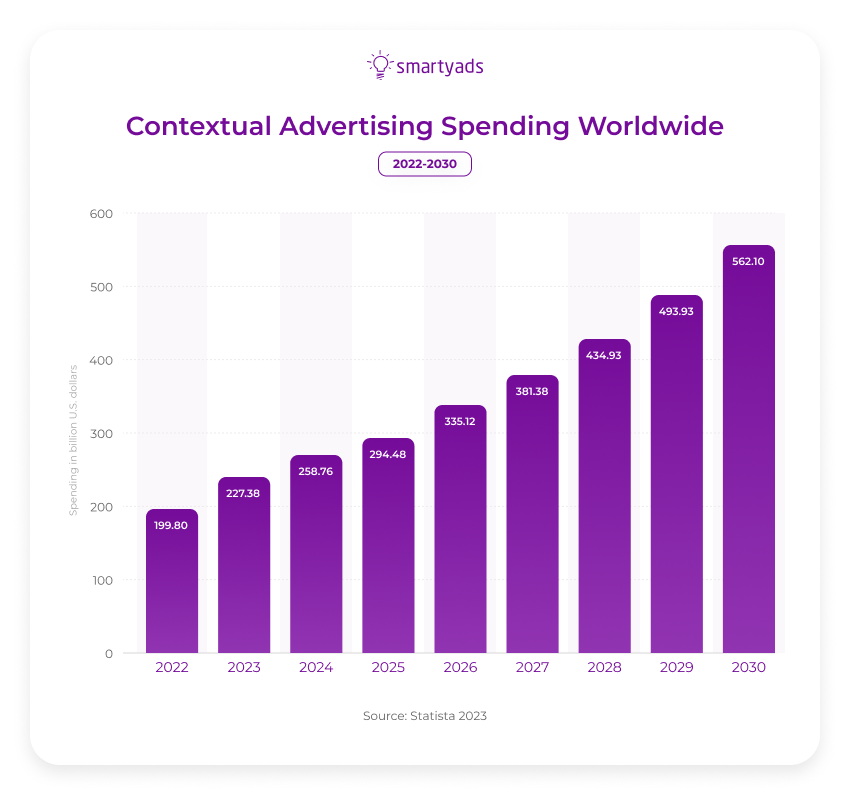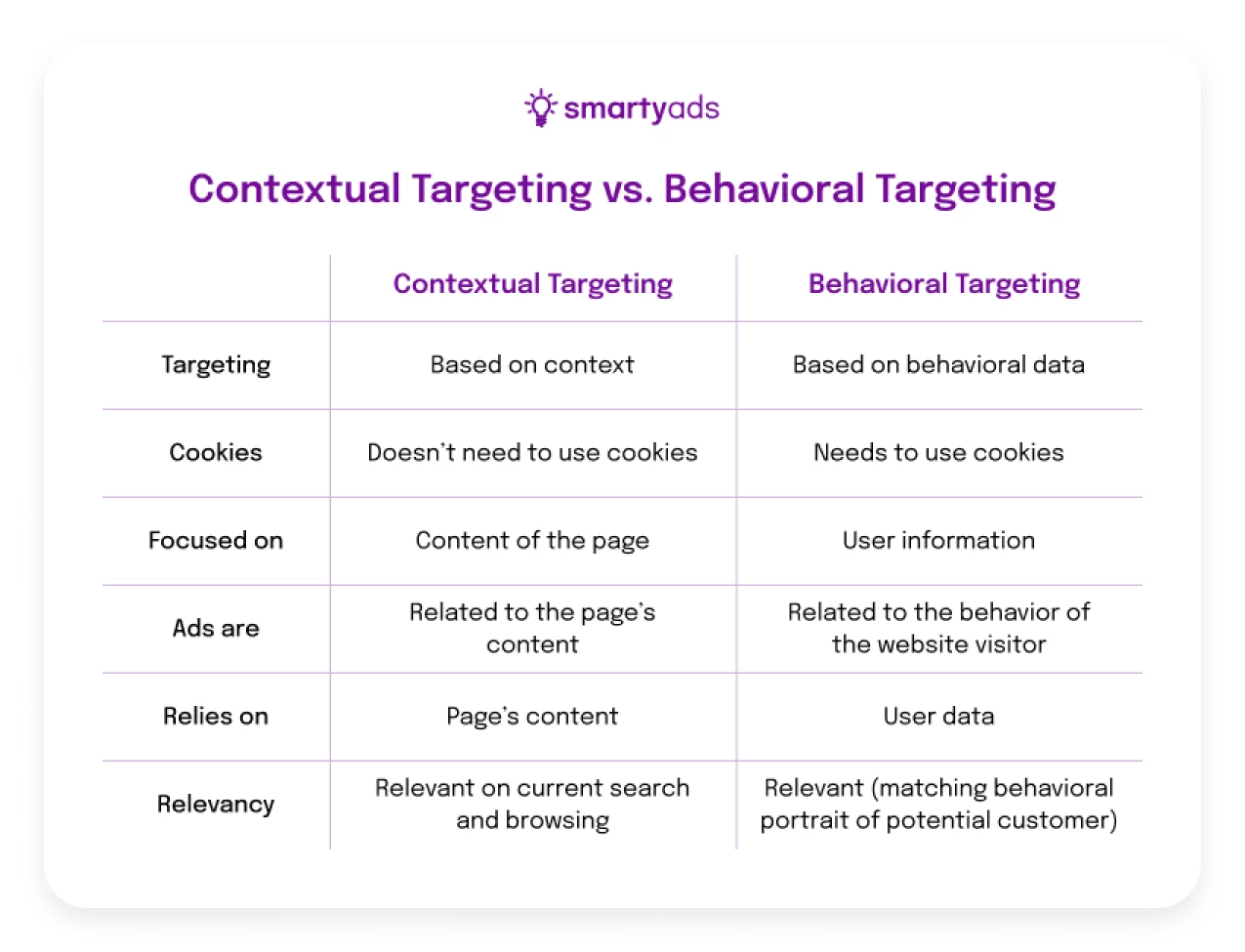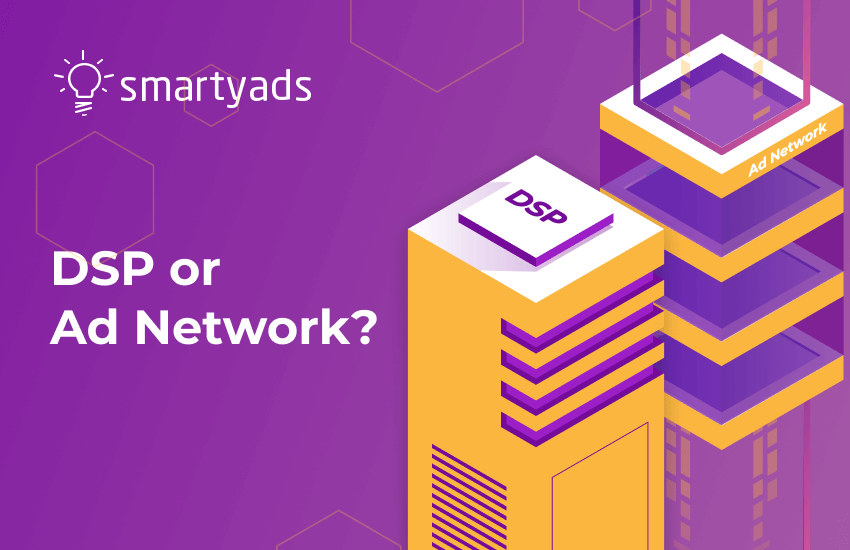Ever notice how, when you’re browsing an article about hiking trails, you’re suddenly shown an ad for the latest outdoor gear? Or how can a blog post about productivity be perfectly paired with a promotion for time management tools? That’s not just clever coincidence — it’s the power of contextual targeting in action.
Contextual advertising has evolved significantly. It’s no longer just about matching ads to keywords. Thanks to AI and machine learning, it has become a smarter system. This technology understands what you’re reading. It also grasps the mood and intent behind the content. It's exciting to see how this evolution impacts advertisers in 2024. Let’s explore the changes!
The evolution of contextual targeting: a journey from basics to AI
According to global stats, contextual advertising will reach $258,56 billion in 2024. By 2025, it may even reach $294,48 billion in ad spend. Privacy-friendly contextual targeting has captured the hearts of advertisers because they have been searching for viable alternatives for years. Additionally, it happened because they are striving to diversify their approaches to targeting advertising.
More so, in 2024, contextual capabilities gained some new amazing capabilities. AI implementation into advertising platforms, machine learning integration, and natural language processing magnified the strengths of contextual targeting and increased precision.

The early days: basic keyword matching
In the early days of online marketing, contextual targeting was fairly straightforward. Algorithms would scan the text on a webpage and serve ads based on simple keyword matches. If you were reading about cameras, you'd see an ad for lenses or photography gear. It was effective to a point, but its limitations were clear. The system didn’t understand the nuances of content — it just looked for words.
Entering AI and machine learning: a new era begins
If we look at where we are today, contextual targeting has really evolved. Gone are the days when it was all about simple keywords. Now, advancements in Artificial Intelligence (AI) and Machine Learning (ML) have made these systems much smarter. They use Natural Language Processing (NLP) to understand the content better. They also grasp the broader context surrounding that content. This shift has changed the game for targeted advertising.
- AI doesn’t just ‘read’ words; it understands the meaning behind them.
- NLP identifies tone, sentiment, and even cultural nuances, ensuring the ads are aligned not just with the topic but with the user’s mindset.
For example, AI can now distinguish between an article praising a tropical vacation and one that’s critical of the environmental impacts of tourism, placing the right ads in front of the right audience.
Supercharged by learning: constant improvement
One of the most exciting aspects of this revolution is machine learning. These advanced systems are constantly improving, learning from vast datasets. They can refine ad placements by identifying patterns in user behavior and adjusting them in real time.
- No more static campaigns: As users engage, AI learns and adapts.
- Hyper-specific environments: Ads are now placed in contexts that perfectly match the user’s interests and emotional state.
The result: smarter ads, happier users
This shift has had a profound impact on both the user experience and advertisers:
- Users receive more relevant, less intrusive ads, which feel natural rather than forced.
- Advertisers see increased engagement because ads are more aligned with the user’s mindset and the content they’re consuming.
By understanding and predicting what kind of content users are interacting with, these systems now deliver precisely tailored ads in ways that feel seamless and even welcome.

Why is contextual targeting important?
Contextual targeting plays a pivotal role in digital contextual advertising. It enhances the relevance of ads by aligning them with the webpage content. This increased relevance boosts the chances of capturing users' attention and matching their interests.
Additionally, contextual targeting improves the overall user experience. Integrating ads seamlessly within the surrounding content creates a less intrusive browsing journey. As a result, users are less likely to see these ads as disruptive, leading to a more positive online experience.
What are the benefits of contextual targeting for advertisers?
Contextual targeting in digital advertising has many undeniable advantages. First of all, it increases the relevance of ads by matching the content and context of the web pages being served.
User privacy
Contextual targeting emerges as a privacy-savvy alternative to intrusive tracking methods. This is especially important in an age dominated by data privacy concerns. It allows advertisers to connect with their target audience while reducing their dependence on extensive user data. This approach effectively addresses privacy apprehensions and potential regulatory challenges.
Personalized ad experience
Contextual targeting provides you with the authority of precise ad positioning within its surroundings. Advertisers have the autonomy to select the placement and adjacent content for their ads independently.
This empowers them to harmonize the brand message with the adjacent content, ensuring a competent delivery of the intended message to potential clients.
Also, contextual targeting reveals its versatility as a strategy applicable across various industries and niches. Promoting products, services, or content can be finely tailored to suit specific campaign objectives.
More cost-effective advertising method
Campaign performance is what makes contextual targeting truly attractive to advertisers. Synchronizing ads with relevant content often yields higher engagement and click-through rates (CTR). This inherently increases the effectiveness of ad campaigns and leads to a more favorable return on investment (ROI).
Contextual advertising arises as a cost-efficient strategy, combining precision and effectiveness. It enhances engagement and maximizes ad spend efficiency by delivering closely aligned ads with webpage content. Advertisers enjoy real-time optimization and scalability, customizing campaigns to their goals and budget. Operating on a pay-per-click model, this method assures cost control while attracting high-quality traffic.
Easier and more affordable to implement
Moreover, contextual targeting seamlessly adjusts to the dynamic Internet landscape. Advertisers can effortlessly tweak targeting criteria in response to current trends, breaking news, and emerging content, guaranteeing the relevance and timeliness of their campaigns.

Contextual targeting vs. behavioral targeting
In the field of contextual advertising, there are two main targeting methods: contextual and behavioral.
Contextual targeting primarily concerns webpage content. Advertisers employing this method aim to synchronize their ads with the context and subject matter of the hosting webpage. Emphasis is placed on relevance, ensuring the ads closely align with users' content-related interests and needs.
Behavioral ad targeting relies on user data and prior online engagements. It tracks user activities, including browsing history, search queries, and interactions with websites and applications. This approach involves user profiling and segmentation. As a result, advertisers can serve personalized ads based on a user's previous online behavior.
Sometimes context matters more than behavior
The core distinction between these two approaches lies in their dependence on user data. Behavioral targeting heavily relies on user data to forecast preferences and serve personalized ads. Conversely, contextual targeting minimizes the necessity for extensive user data by giving precedence to the immediate context of the user's content interaction.

Privacy considerations are a vital factor in this evaluation. Personalized behavioral targeting relies on user data. It often faces scrutiny and regulatory hurdles about data privacy and consent. In contrast, contextual targeting is viewed as a privacy-conscious alternative. This approach requires less intrusive tracking of individual user behavior.
Relevance and user experience: prioritizing both
Contextual targeting shows ads that blend seamlessly with the content a user is viewing. This approach makes the ads feel less intrusive. It also makes them more engaging. On the other hand, behavioral targeting emphasizes personalization. While it can offer relevant ads, it may raise privacy concerns. Many users feel uneasy when they realize their online behavior is being tracked. This is especially true with location-based ads.
Choosing the right approach
Deciding between contextual and behavioral targeting depends on the brand's goals. Contextual targeting is great for building brand awareness. It places ads next to relevant content, helping you reach a wider audience. On the other hand, behavioral targeting focuses on specific actions. It tailors ads based on individual behaviors. This makes it much more personal and effective for driving conversions.
Finding the balance
Both approaches have strengths. The decision between them often depends on various factors, including campaign objectives, privacy requirements, and the desired level of personalization. In some cases, a hybrid strategy can provide the best results. This approach combines elements of both strategies. It offers a balance between relevance, engagement, and respect for user privacy.
What is contextual traffic?
Contextual traffic refers to website visitors who arrive at a specific web page based on their interests or search queries. This traffic is driven by the relevance of the content to the user's preferences or needs.
Unlike direct or referral traffic, which comes from specific sources, contextual traffic relies on the alignment between user intent and the content.
For example, if a user searches for "best smartphones" and clicks on a result leading to a tech review website, that user is considered contextual traffic. Their visit is driven by the relevance of the content to their initial search query.
How to maximize the power of contextual traffic
Contextual traffic is a real boon for website owners and advertisers. It shows that users connect better with content or ads that resonate with their interests. This connection results in higher engagement rates. Visitors tend to stay on the site longer. Plus, it boosts the likelihood of conversions. This can mean making a purchase or signing up for a newsletter.
To leverage contextual traffic effectively, website owners and advertisers should optimize their content and strategies. They can do this by aligning with specific keywords, topics, or user intent. This involves creating high-quality, relevant content and using keyword targeting in advertising campaigns. Overall, contextual traffic is crucial for driving user engagement and achieving online objectives.
Google AdSense and contextual targeting
Google AdSense stands as a cornerstone of the digital advertising landscape, serving as a popular monetization tool for website owners and publishers. It presents a seamless avenue for content creators to accrue revenue by showcasing ads tailored to their web pages' context.
This contextual alignment is achieved through the advanced algorithms of Google Display Network, which meticulously assess target keywords, themes, and content subject matter to guarantee the utmost relevance and pertinence to users' current engagement.
This symbiotic relationship between content and advertising yields mutual benefits for publishers and advertisers. For publishers, it offers a user-friendly income-generation avenue that preserves the quality of the user experience. Still, aside from this tool, in 2024, the AdTech landscape is ready to offer a plethora of programmatic advertising platforms, each of which has unique advantages and sometimes unique tools for running contextual advertising campaigns.
Beyond Cookies: The future is contextual
We’ve all been following the saga with cookies shutdown as Google delayed the decision year after year. Although it was initially planned for 2020, Google wanted businesses to adapt properly and was looking for a new equivalent tool that would successfully substitute the previous mechanism. Now, as cookies are returned to the menu, it might just be a matter of time before they are finally gone. One thing that gets clear is that advertisers should never lay all eggs into one basket and rely only on a single way of targeting.
The essence of the contextual approach is that it thoroughly interprets the web page content so that ads can be displayed in a meaningful way. It also ensures that it resonates with users’ needs and the content that they read or browse. Thanks to this, GDPR and CCPA regulations are also taken into account, meaning that privacy is prioritized.
One key advantage of contextual advertising is its ability to deliver relevant ads. Users are more likely to find contextually relevant ads valuable and engaging. As a result, contextual advertising often leads to better ad performance. This includes higher click-through rates and increased conversions.
Moreover, contextual advertising is future-proof. It adapts to evolving privacy standards. In a landscape of changing privacy regulations, it remains a reliable and effective method for reaching target audiences.
How to implement it? Meet contextual targeting on SmartyAds DSP!
Implementing contextual targeting in advertising can feel overwhelming. The process starts with selecting the right platform for your campaign. With so many contextual advertising solutions available, it’s easy to get lost.
The decision is ultimately yours. For example, SmartyAds DSP offers some impressive benefits for running an effective contextual advertising campaign.
SmartyAds DSP recently added a contextual targeting feature. This feature is a great opportunity for advertisers and brands to stop relying on cookies. Even though the anticipated 2020 cookie phase-out has not happened, digital marketing trends are moving towards maximizing privacy for Internet users. Contextual targeting allows you to precisely target your ads to the desired users while respecting their anonymity.
The introduction of such ads will also have a positive impact on user engagement rates with advertising content, as it will already be surrounded by content that the user is interested in.
In the following article, we'll explain exactly how the contextual targeting feature on SmartyAds DSP will work. Check it out if this sounds like something your brand needs!
Start advertising with SmartyAds DSP now!
FAQ
Contextual targeting is an advertising strategy that delivers ads based on the context of web content. It matches ad content to the themes, keywords, and subject matter of the webpage, ensuring relevance for the audience. This approach respects user privacy, as it doesn't rely on individual user data but focuses on the context of the content to enhance ad engagement.
Contextual targeting thrives because it doesn't rely on tracking user data. Instead, it focuses on the context of web content to serve relevant ads. This approach respects user privacy, aligns with stringent privacy regulations, and offers an effective alternative for advertisers to reach their target audience in a privacy-compliant manner.
Yes, it is possible to launch a contextual campaign on SmartyAds DSP. With the newly introduced contextual targeting functionality, advertisers can run campaigns that target users based on the content they are viewing, ensuring ads are placed in brand-safe and relevant environments without relying solely on cookies.





